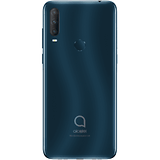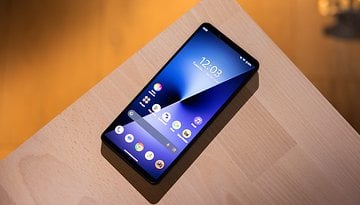Alcatel 1S (2020) review: how good is a $100 smartphone?


Launched in 2020 with an extremely affordable price point of less than €100 in Europe, our review of the Alcatel 1S (2020) has one mission: to set out to prove on whether it is possible to fork out very little money in order to enjoy features found in a modern smartphone. On paper, the Alcatel smartphone comes with an intelligent triple camera, a large 4,000 mAh battery, and a borderless 6.22-inch display with a discreet notch, which is a whole lot of promises. However, Alcatel also offers the Alcatel 3L, which comes with more RAM and a 48-megapixel camera, for just €30 more. Is buying the Alcatel 1S (2020) at all?
Good
- Beautiful design and solid workmanship
- Convincing display with good color reproduction
- Latest Android 10 with useful apps
- 4,000 mAh battery
Bad
- Poor hardware
- Poor performance
- Only 32GB of storage
- Poor triple camera performance
- Mono-speaker that delivers muted audio performance

Alcatel 1S (2020) release date and price
In July 2020, the Alcatel 1S dipped below the €100 ($110) mark on online stores. Hailing from the French smartphone manufacturer (which in turn, the company belongs to the Chinese conglomerate TCL), it looks anything but cheap having seen its product photos and description. The teardrop notch in the 6.22-inch display is discreet, the 4,000 mAh battery promises a long-running time, and Alcatel has placed three cameras on the back.
There are no varying hardware configurations to choose from. However, Alcatel lets you decide on the color of the smartphone when you decide to pick one up. For our review, we used the Alcatel 1S (2020) in "Power Gray". Alternatively, the phone is also available in a bluish-green dubbed "Agate Green". This smartphone comes with an included plastic case that covers just the back and a charger, all nicely packed in a blue and white cardboard box. The 10-watt charger is perfectly suited for a smartphone without a quick-charging function.

Alcatel also supplies a micro-USB cable and a headset with a 3.5-millimeter jack connection. The latter is only suitable for telephone calls at best due to a complete lack of bass power - especially if you have a telephone appointment with Kermit the Frog. But if Alcatel scrimped on the headset, this might have a positive effect on the components located underneath the hood.
Current Android, old processor
The Alcatel 1S (2020) is powered by the Mediatek MT67262D Helios P22 chipset. Thus Alcatel unfortunately not only threw in a rather archaic smartphone processor from 2018 in this cheap device, the "D" suffix also indicates a lower clock rate that plods along at a sluggish 1.8 GHz. Alcatel has mated the processor to 3 GB RAM, where both of these end up delivering a rather weak performance in the end.
The installed Android 10 operating system launches its apps sluggishly, which is something that you will notice right away even in your everyday navigation, showing that the hardware used in this cheap smartphone has long reached its limits. Using the Alcatel 1S (2020) in everyday life would unfortunately also translate to living with jerkiness and long loading times. Graphically elaborate mobile games like PUBG Mobile boot up after what feels like an eternity, and then you will have to 'suffer' through extremely low frame rates which makes it not worth playing in the first place. Needless to say, this is the reason why I lost my test match after a few minutes.
It is a pity that Alcatel simply relies on weak hardware to run Android 10. This is not to detract from what the manufacturer has done with the operating system, as the adapted version of Android 10 looks tidy. Apart from a sensible child mode, there are only a few pre-installed apps that can be easily uninstalled, which is good news for those who do not want any bloatware. Alcatel is only a month behind the security updates from Google compared to the Google Pixel 3XL. Additions like a system-wide search in the App Drawer are also very useful, but again the weak performance rears its ugly head here. This plodding and ponderous performance runs through the entire 1S (2020).
Features: triple camera, fingerprint sensor and dual SIM
Trying out the triple camera including ultra-wide-angle and macro lens, alongside practical integration of Google Lens hence becomes a game of patience. You'll have to wait just approximately two seconds before the phone switches from standard view to ultra-wide-angle. The macro lens, which Alcatel also uses to obtain depth information for its portrait mode, is also only accessible via the advanced camera menu, which makes the triple camera look more like a two-lens system.

The specifications sheet contains the following information about the triple camera:
- Resolution: 13 MP + 2 MP + 5 MP
- Autofocus Single-tone flash
- Lenses: 5P + 4P + 3P
- Aperture: f/1.8 + f/2.2 + f/2.4
- Sensor size: 1/3.06 inch + 1/5 inch + 1/5 inch
- Pixel size: 1.12 μm + 1.12 μm + 1.65 μm
- Video recording and playback: 1080p at 30 bps
- Functions: AI scene detection, bokeh, face enhancement, HDR, macro, night mode, panorama, real-time photo filter

As you can see in the test pictures, the camera quality is not very satisfying. All in all, the triple camera ends up as 'false advertising' that overpromises, because with a 2-megapixel sensor and a 5-megapixel sensor, Alcatel should have saved itself two additional lenses by omitting them. After all, even the 13-megapixel main camera will hardly be considered as decent in 2020.

But apart from the smartphone photography, the rest of the hardware can be deemed decent at this price point. Besides the modern WLAN 801.11n standard, Bluetooth 5.0 connectivity is also part of the deal. A 3.5-millimeter headphone jack is also a welcome addition in smartphones that are released this year. In addition, the fingerprint sensor on the back quickly recognizes stored patterns, and the battery is ample enough for whole day use at 4,000 mAh capacity. However, the internal memory which maxes out at 32 GB is simply too small for today's use, but that can't be helped because of the price point. With a microSD card, you can up the storage space by another 32 GB.
However, thanks to the combined SIM card slot, the dual SIM card capability is lost since you will have to make the difficult choice of either having more memory or throwing in a second SIM card. When it comes to audio playback, Alcatel relies on a mono loudspeaker at the bottom to get the job done. Unfortunately, it does a rather poor job out of it in terms of sound reproduction that is muffled at best while lacking clarity. Even pumping it up to the maximum volume level does nothing much.
Conclusion: most likely your next bad buy
For a long time, I thought about who I would advise buying the Alcatel 1S. This is because the design actually appeals to me, and the beautiful display of this cheap smartphone is worth looking into. However, both are also available in the Alcatel 3L, which is only €30 more expensive, and with that added amount, the manufacturer not only throws in more RAM, but also a faster processor variant. So, if you like the design or have nostalgic memories of the Alcatel One Touch, you should definitely fork out the additional dough. How the Alcatel 3L performs in comparison will be shown in a review in the coming days.
If you don't care about design and manufacturer, there are even better alternatives by stumping up a little bit more money. The surcharge can be justified as a long-term investment, because you might not be satisfied with the Alcatel 1S for a long time. Above all, we recommend the Motorola G8 for €199 ($227) in the under €200 ($227) price point. This model from Motorola also comes with a 4,000 mAh battery and even an additional camera. Motorola also relies on a far superior Snapdragon 655 chipset. For those who find the G8 too expensive, the Nokia 4.2 is an alternative for only €89 ($101). More details about both devices can be found on the linked page, where we present detailed information in our Best Smartphones for under $200 buying guide.





















-
Admin
Jul 10, 2020 Link to commentThis shows that it is possible to have decent phones at a decent price.
In straight cost for parts, it's certainly possible. But not if there's profit and assembly involved.